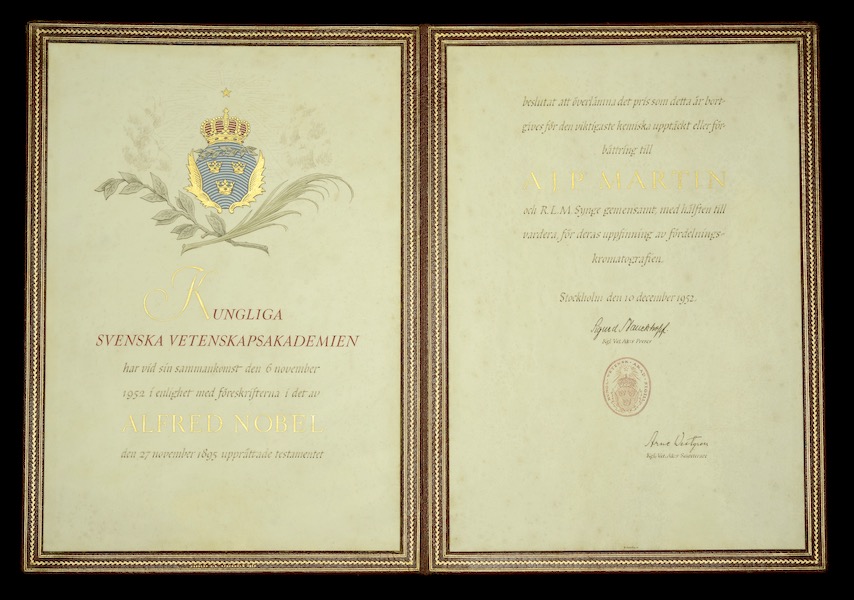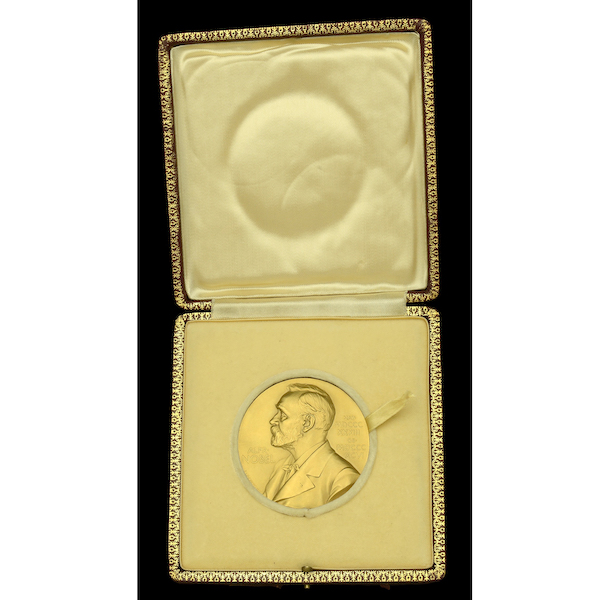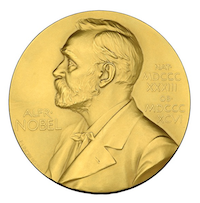
LONDON – The Nobel Prize medal awarded to chemist Archer Martin in 1952 was sold by Noonans February 2 in an auction of Coins and Historical Medals for a hammer price of £150,000 (about $180,000). It was consigned by his family and was bought by a private collector in Europe, who was bidding via the telephone.
Special Projects Director in the Coins department at Noonans Peter Preston-Morley commented: ”Archer Martin was a brilliant scientist whose discoveries led to extraordinary advances in medicine and other fields and won him the Nobel Prize for Chemistry in 1952, but cruelly could not help his own mental decline. He was a fearless guinea pig for drug testing to transform the lives of Alzheimer’s sufferers and delighted researchers when his condition improved.”
The public first became aware of Archer’s genius when he shared the Nobel Prize for chemistry in 1952 with Richard Synge for their ground-breaking invention of partition chromatography, an effective method of separating compound elements that had far-reaching implications for analytical chemistry.

Archer’s singular intellect and approach to life were evident from childhood. Unable to read at the age of nine, the breakthrough came when he was given a book about batteries and couldn’t find anyone in the household to read it to him. He realized he could decode it and became a competent reader.
Archer suffered with stomach ulcers, and during wartime, he was allowed extra milk as an anti-inflammatory. When his ulcer became very troublesome in later life, he was puzzled that milk then proved ineffective. Learning that pasteurization methods had changed, he experimented with unpasteurized milk but was annoyed to find himself putting on weight. He decided to separate the milk and found the active ingredient in the whey, which he could then concentrate. He persuaded various companies to test the extract, which they found effective at calming inflammation. He demonstrated this himself by burning his arms with cigarettes, but they refused to invest in his discovery because, whey being a natural product, it could not be patented.
He suffered intermittently from depression. On reading Not All In The Mind by William Sargant – one of his daughter’s university textbooks – on the treatment of shell shock, he was prescribed monoamine oxidase inhibitors, which he found very effective.

One of the most successful experiments he took part in was as a patient rather than a researcher in a trial involving the THA (Tetrahydroaminoacridine) drug for Alzheimer’s disease. After just a short course of the drug, not only was Archer able to discuss the possible effects coherently, but he also managed to criticize research proposals shared with him by a colleague. Unfortunately, damage to his liver meant that he had to have a break from the drugs.
Archer’s scientific legacy remains widespread today. Chromatography is a technique for separating components in a substance. Many specialized types have been developed for specific purposes and are essential tools for the life science industries. These include testing for drugs in blood, urine and breath, and the development of new drugs. They are used in the development of vaccines and their purification. In food production they analyze ingredients, toxic impurities and pesticide residues. They are relied upon for detection of pollutants in the environment, in soil, water and air.
Archer, a teetotaller, was amused to realize his work had made possible the breathalyzer.



